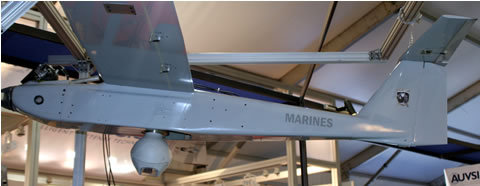MTC Technologies MQ-17 SpyHawk
By 2006, the U.S Marine Corps had identified a future gap in unmanned aerial reconnaissance capability at division level, or "Tier II" in the USMC's UAS (Unmanned Aerial System) hierarchy. The current UAV used in this role, the Boeing/Insitu ScanEagle, is regarded as an interim platform only. In November 2006, the MCWL (Marine Corps Warfighting Laboratory) awarded MTC Technologies a contract to demonstrate "Tier II" UAS technologies using their SpyHawk UAS. In mid-2007, the official designation XMQ-17A was allocated to the SpyHawk UAV.
 |
| Photo: via Defense Update |
| XMQ-17A |
The XMQ-17A is based on the T-15/T-16 family of UAVs developed by Arcturus UAV. The UAV is launched from a trailer-mounted pneumatic launcher, and is powered by a single Honda GX-57 gasoline-fueled piston engine. It can carry a maximum payload of about 9 kg (20 lb) for a mission duration of up to 16 hours. The primary payload, a stabilized EO/IR camera package and laser designator, is housed in a belly-mounted turret, which can be fully retracted into the fuselage before landing. The ground control station includes a modified PlayStation video game controller to operate the aircraft, 3D mapping software for navigation, and a dual-screen monitor for simultaneous observation of the real-time imagery and the vehicle's operational and navigational status.
The XMQ-17A was to evaluate the operation of the UAV system itself, as well as possible payloads and applications like communications and data relay, electronic signals intelligence, electronic warfare, hyperspectral imaging and a synthetic aperture radar. However, in January 2008, MTC announced that it has entered a cancellation agreement with the Marine Corps, and that it will return all performance-based fees to the USMC. This appears to indicate that the SpyHawk UAS clearly failed in the demonstrations conducted so far. The decision to terminate the XMQ-17A evaluation had already been taken in late 2007, when MTC Technologies' acquisition by BAE Systems was negotiated.
Specifications
Note: Data given by several sources show slight variations. Figures given below may therefore be inaccurate!
Data for XMQ-17A:
| Length | ? |
| Wingspan | 3.89 m (12 ft 9 in) |
| Weight | 39 kg (85 lb) |
| Speed | 167 km/h (103 mph); cruise: 83 km/h (52 mph) |
| Ceiling | 4500 m (15000 ft) |
| Range | > 90 km (50 nm) |
| Endurance | 16 h |
| Propulsion | Honda GX-57 piston engine |
Main Sources
[1] MTC Technologies Press Releases
[2] Henry S. Kenyon:
"Airborne
Testbed Opens New Possibilities", SIGNAL Magazine, May 2007
[3] Defense Update Website
Back to Directory of U.S. Military Rockets and Missiles, Appendix 2
Last Updated: 22 January 2008